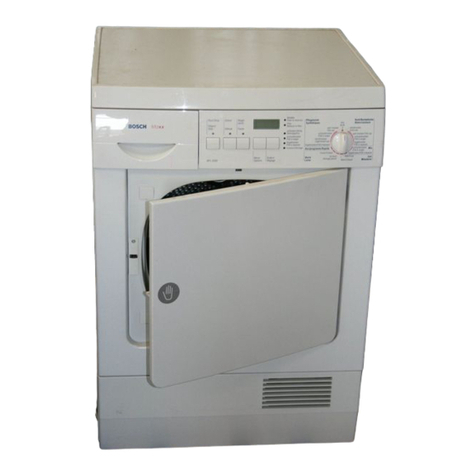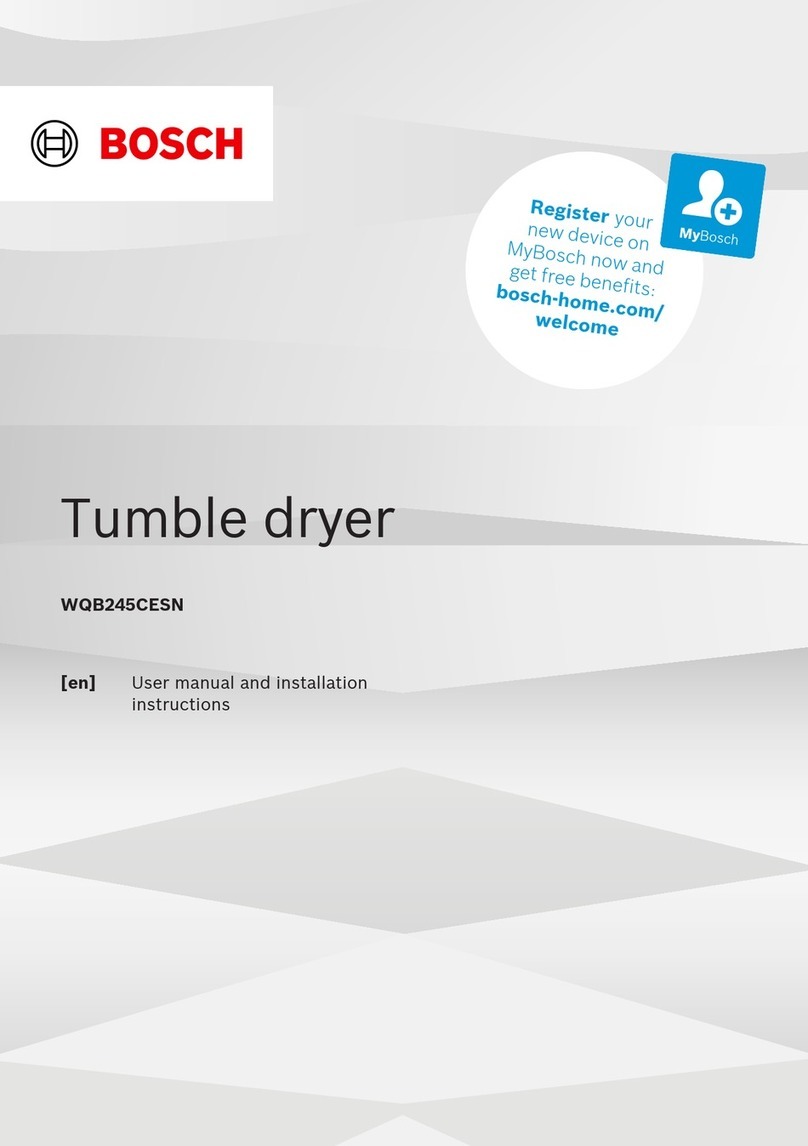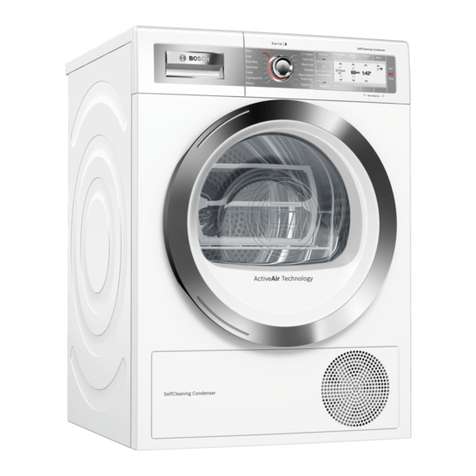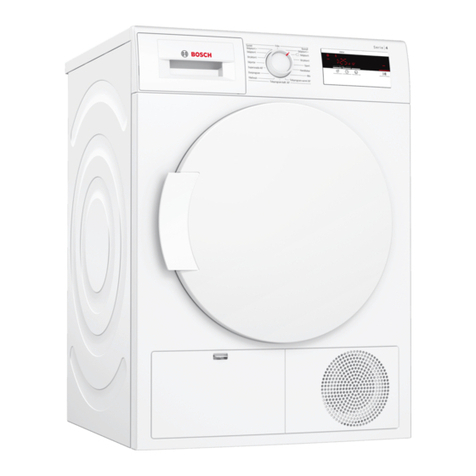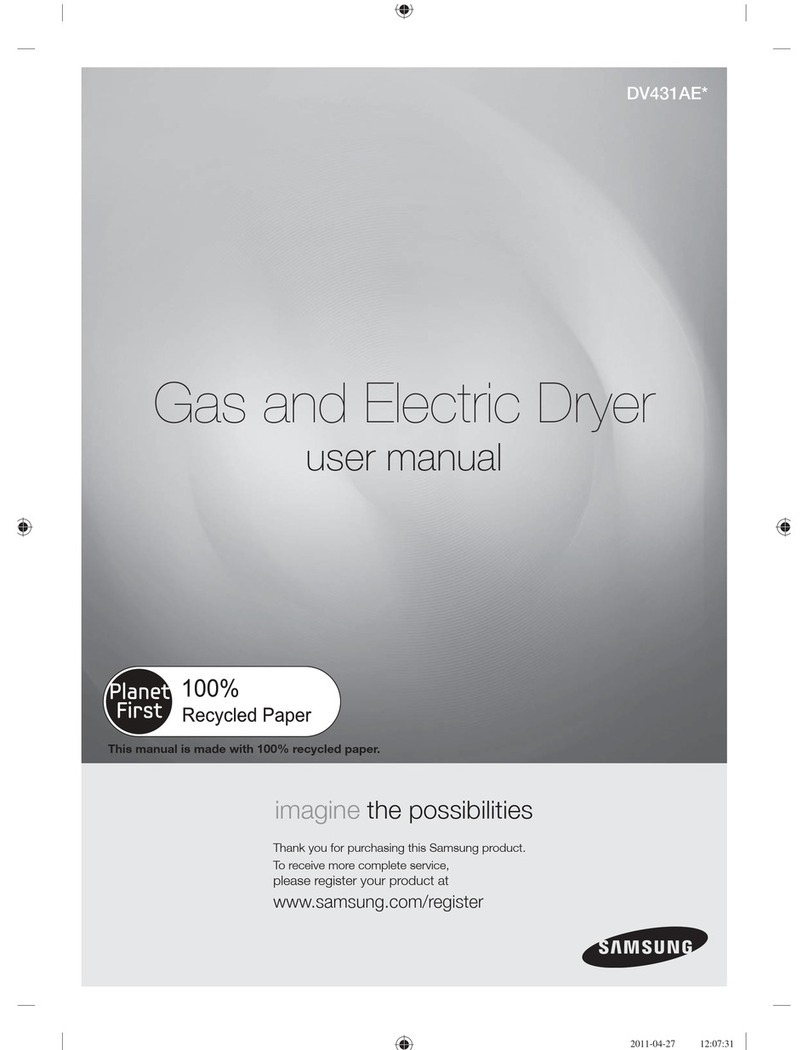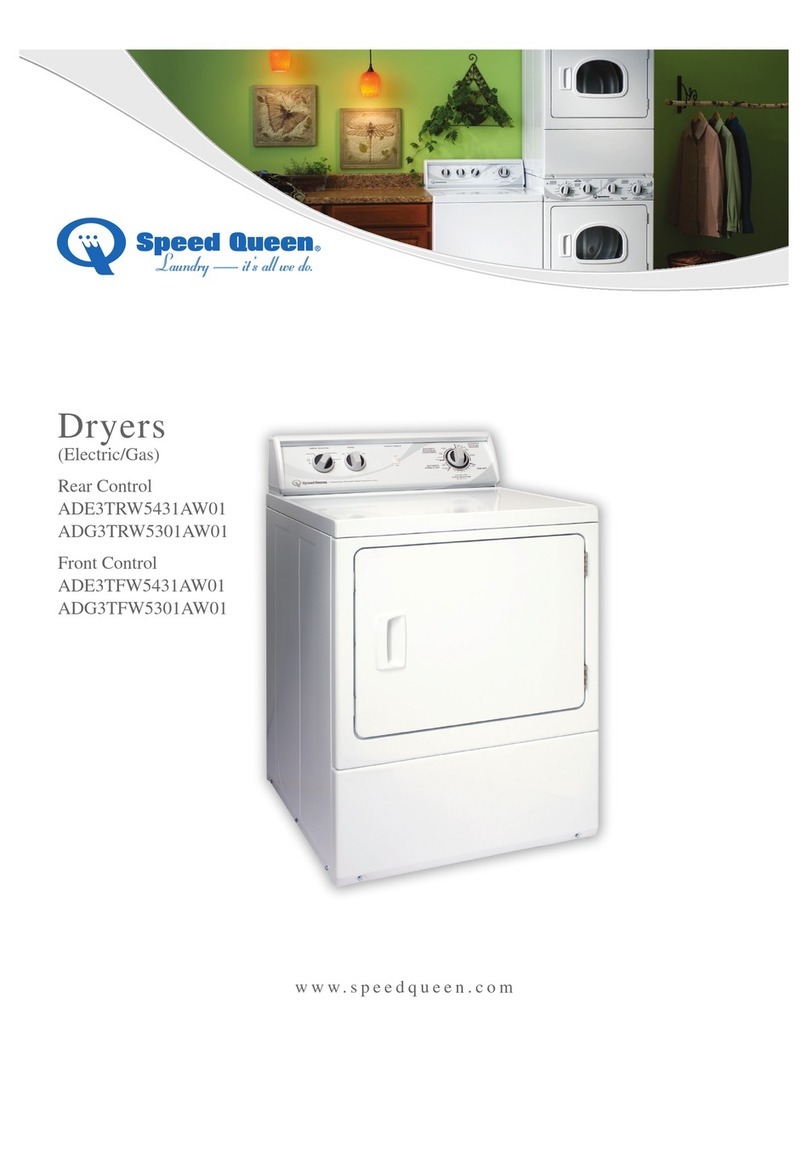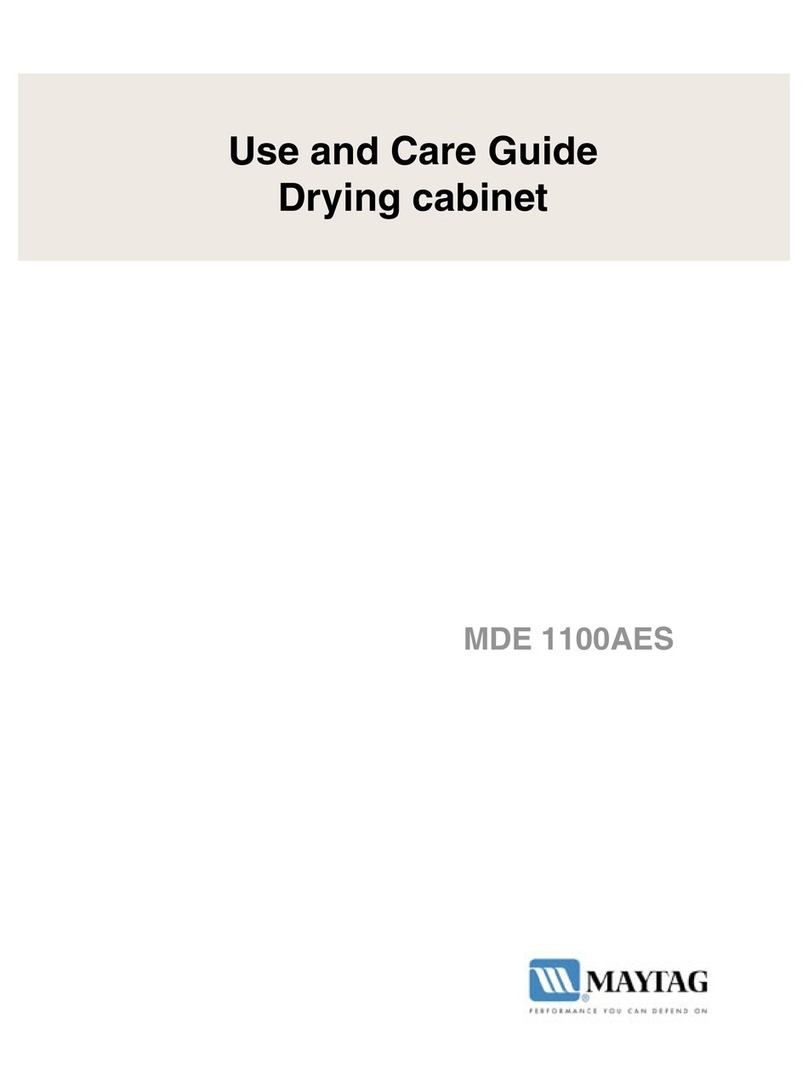
7
Programme overview also see Page 5
Sort the laundry according totype of textile and fabric. Fabrics must be suitable for tumble drying.
After drying... ciron laundry lightly iron laundry @cdo not iron laundry cmangle laundry
PROGRAMMES TEXTILE TYPE AND INFORMATION
** LCottons max. 7 kgHard-wearing fabrics, boil-resistant fabrics made of cotton or linen.
** IEasy-Care max. 3.5 kgNon-iron laundry made of synthetic fibres and blended fabric, easy-care cotton.
*|Iron Dry c÷@c Fabrics suitable for ironing (iron fabrics in order to avoid creasing).
c*+cCupboard Dry @Single-layer fabrics.
*÷Cupboard Dry Plus @Fabrics made of thick, multilayered items of clothing.
Timed program
20’ warmmax. 3 kgPre-dried, multi-layered, sensitive fabrics made of acrylic fibres, or separate small items of laundry.
Also for subsequent drying.
ASuper Quick 40’ max. 2 kg
Laundry made of synthetic fibres, cotton or blended fabrics (for example) that needs to be dried quickly. The values may differ
from the those specified depending on the type of fabric, mixture of laundry to be dried, residual moisture in the fabric and
loading capacity.
ZSportswear max. 1.5 kgFabrics with membrane coating, water-repellent fabrics, functional clothing, fleece fabrics (dry jackets/trousers with
removable internal lining separately).
*for LCottons and IEasy-Care programmes only.
**Dryness levels can be selected individually aCupboard Dry Plus,c+ Cupboard Dry and |Iron Dry (depending on the model).
Degree of dryness can be finely adjusted; multi-layered textiles require a longer drying time than single-layered items of clothing.
Recommendation: Dry separately.
9608 / 9001232029
*1232029* Robert Bosch Hausgeräte GmbH
Carl-Wery-Str. 34
81739 München/Deutschland
WTE84106ZA
8
Installation
–Delivery specification: dryer, instructions for installation and use, woollens basket
(depending on model).
–Check dryer for transport damage.
–The dryer is very heavy. Do not attempt to lift it on your own.
–Be careful to avoid sharp edges.
–Do not lift the dryer by any of the protruding parts (e.g. the door) as they may break off.
–Do not set up in a room that is susceptible to frost. Freezing water may cause damage.
–If in doubt, have the appliance connected by an expert.
Setting up the dryer
–The appliance plug must always be accessible.
–Ensure that the appliance is installed on a clean, level
and solid surface.
–Keep the cooling grille at the front of the dryer
unobstructed.
–Keep the area around the dryer clean.
–Make the dryer level using the threaded feet
and a spirit level.
Do not remove the threaded feet under any
circumstances.
Mains connection see safety instructions aPage 11.
–Connect to an AC earthed socket. If in doubt have the socket checked by an expert.
–The mains voltage and the voltage shown on the rating plate (aPage 9) must correspond.
–The connected load and necessary fuse protection are specified on the rating plate.
Converting the installed load Note the fuse protection of the socket.
10/16 Amps
Frost protection / Transport
Preparation
1. Empty the condensate container apage 4.
2. Select any programme using the programme selector.
3. Press the Start/Stop button acondensation is pumped into the container.
4. Wait 5 min. and then empty the condensate container again.
5. Turn the programme selector to Off.
1. Take all accessory parts
out of the drum.
The drum must be empty.
Make sure that the air
inlet remains unobstructed
Clean and level
2.
3.
turn to
Off
press and hold selection
then turn 3 x to the right turn to
Off
set
amperage
1 x to the
right
Feedback (depending on model): off
flashes
10 A
16 A
Do not operate the dryer if
there is a danger of frost.
Do not set up the dryer behind a door or sliding
door as this may obstruct or prevent the dryer door
from opening. This will prevent a potentially fatal
danger to children from locking themselves in.
9
Technical data
ʠDimensions (DxWxH) 60 x 60 x 85 cm (height adjustable)
Weight approximately 45 kg
Max. capacity 7 kg
Condensate container 4.2 l
Connection voltage
Connected load
Fuse protection see appliance rating plate
Ambient temperature
Product number/
Production number
You can find the rating plate on the back of the dryer.
Power consumption when switched off0.10 W
Power consumption when ready for use (left-on mode) 1.00 W
Consumption values table
Programme
Spin speed which
is used for spinning
the laundry
Duration** Energy consumption**
Cottons
7 kg 3,5 kg 7 kg 3,5 kg
10 A 16 A 10 A 16 A 10 A 16 A 10 A 16 A
Cupboard dry* 1400 rpm 112 min 98 min 93 min 63 min 3.54 kWh 3.54 kWh 1.95 kWh 1.95 kWh
1000 rpm 131 min 115 min 100 min 70 min 4.13 kWh 4.13 kWh 2.27kWh 2.27 kWh
800 rpm 150 min 133 min 116 min 86 min 4.72 kWh 4.72 kWh 2.79 kWh 2.79 kWh
Iron dry* 1400 rpm 93 min 69 min 78 min 48min 2.55 kWh 2.55 kWh 1.78 kWh 1.78 kWh
1000 rpm 111 min 82 min 87 min 57 min 3.22 kWh 3.22 kWh 2.23 kwh 2.23 kwh
800 rpm 130 min 94 min 98 min 68 min 3.90 kWh 3.90 kWh 2.81 kwh 2.81 kwh
Easy-Care 3.5 kg 3.5 kg
Cupboard dry* 800 rpm 48 min 42 min 1.35kWh 1.35 kWh
600 rpm 60 min 51 min 1.65kWh 1.65 kWh
*Programme setting for testing in accordance with the applicable IEC61121 standard.
** The values may differ from those specified, depending on the type of fabric, composition of laundry to be dried, residual moisture in the fabric,
the degree of dryness that has been set, the amount of laundry being loaded and the environmental conditions.
Optional accessories (from after-sales service using order number, depending on model)
Platform
For easier loading and unloading. The basket contained in the drawer can be used to carry the laundry.
Washer-dryer stack connection set
The dryer can be placed on top of a suitable washing machine with the same width and depth to save space. The dryer must be fastened
to the washing machine using this connection set. With pull-out worktop: WTZ 11300
Connection fittings for condensation outlet
The condensation is conveyed directly via a hose.
WMZ
20500
WTZ
11310
WTZ
1110
10
What to do if ...
If you cannot rectify a fault yourself (e.g. switching off/on), please contact our after-sales service. We will
always find an appropriate solution and will avoid unnecessary visits by engineers. Trust the expertise of
the manufacturer and rest assured that the repair will be carried out by trained service technicians using
original spare parts. The contact details of your local after-sales service can be found in the enclosed after-
sales service directory.
When contacting the after-sales service, please quote the appliance's product number (E no.) and
production number (FD) (see the inside of the door).
Set the programme selector to Off and remove the appliance plug from the socket.
ʠThe Start/Stop indicator lamp does
not light up.
Mains plug plugged in? Programme selected?
Check the socket fuse.
ʠThe display panel light and indicator
lights (depending on model) go out and
the Start/Stop indicator light flashes.
Energy-saving mode is activated asee the separate Energy-
saving mode instructions.
ʠThe ÍContainer and Start/Stop
indicator lights are flashing.
Empty the condensate container.
If featured, check hose for condensation outlet.
ʠThe nFilter and Start/Stop
indicator lights are flashing.
Clean the fluff filter and/or air cooler under running water
aPage 4/6.
ʠDryer does not start. Start/Stop button selected?
Door closed?
Ambient temperature greater than 5°C? The optimum ambient
temperature for drying is between 5 °C and 35 °C.
ʠWater is running out. Align dryer horizontally.
Clean air cooler seal.
ʠThe door opens by itself. Push the door closed until you hear it engage.
ʠCreasing. Laundry load exceeded?
Remove articles of clothing immediately after the end of
the programme, hang up and pull into shape.
Unsuitable programme selected aPage 7.
ʠLaundry is not dried correctly or is still
too damp.
After the end of the programme, warm laundry feels damper
than it actually is. Spread the laundry out and allow the heat to
disperse.
Finely adjust the dryness level – this extends the drying time but
does not increase the temperature. Your laundry will become
drier.
Select a programme with a longer drying time or increase the
drying level. This does not increase the temperature.
Select a time programme for extended drying of laundry that is
still damp.
If you have exceeded the maximum load for the programme, the
laundry may not be dried correctly.
Clean the moisture sensor in the drum. A fine layer of limescale
may adversely affect the performance of the sensors and your
washing will not dry properly.
Drying has been interrupted as a result of a power cut, because
the condensate container is full or because the maximum drying
time has been exceeded.
ʠDrying time too long. Rinse the fluff filters under running water aPage 4.
Insufficient supply of air aensure that air can circulate.
Air inlet possibly blocked aClear inlet aPage 8.
Ambient temperature higher than 35 °C aventilate the room.
The optimum ambient temperature for drying is between 5 °C
and 35 °C. Outside of this range, the drying time may increase.
ʠThe humidity in the room increases
significantly.
Make sure the room is sufficiently ventilated.
ʠPower failure. Remove laundry from the dryer immediately and spread out. This
allows the heat to dissipate. Be careful as the door, the drum and
the laundry may be hot.
ʠOne or more indicator lights for
programme status are flashing.
Clean filter and air cooler aPage 4/6.
Check installation conditions aPage 8.
Switch off, leave to cool down, switch on again, restart
programme.
11
Safety instructions
Emergency –Pull the appliance plug out of the socket immediately or disconnect the fuse.
ONLY use
the dryer...
–in rooms inside the house.
–to dry fabrics.
The dryer must
NEVER...
–be used for other purposes than those described above.
–be modified in terms of its technology or attributes.
Dangers –The dryer must not be used by children or persons who have not been
instructed in its use.
–Do not leave children unsupervised near the dryer.
–Keep pets away from the dryer.
–Remove all objects from pockets. Make especially sure that cigarette lighters
are removed as they constitute an aexplosion hazard.
–Do not lean or sit on the door arisk of tipping.
Installation –Secure loose cables atripping hazard.
–Do not operate the dryer if there is a risk of frost.
Mains
connection
–Connect the dryer according to specifications to an AC earthed socket, as
otherwise it cannot be guaranteed that the appliance is completely safe.
–The cable cross-section must be sufficient.
–Only use earth-leakage circuit breakers with the following symbol:
–The appliance plug and socket must be compatible.
–Do not use multiple plugs/couplings and/or extension cables.
–Do not hold the appliance plug with wet hands arisk of electric shock.
–Never pull the appliance plug out of the socket by its cable.
–Do not damage the mains lead arisk of electric shock.
Operation –Only load the drum with laundry. Check the contents before you
switch the dryer on.
–Do not use the dryer if the laundry has been in contact with solvents, oil, wax,
grease or paint (e.g. hair setting spray, nail polish remover, stain remover,
cleaning solvent, etc.) afire/explosion hazard.
–The tumble dryer is not to be used if industrial chemicals have been used for
cleaning.
–Dust (e.g. coal dust, flour) poses a danger: do not use the dryer
aexplosion hazard.
–Do not turn off the dryer until the drying process ends, unless the laundry will
be removed quickly and spread out, so that the heat can dissipate.
–Do not put laundry containing foamed material/rubber in the dryer
aelastic material may be destroyed and the dryer may be damaged due to
possible deformation of the foamed material.
–Light things, such as long hair, may be sucked into the air inlet of the dryer
aRisk of injury.
–Final part of a tumble dryer cycle occurs without heat (cool down cycle), to
ensure that the items are left at a temperature that ensures that the items will
not be damaged.
–Switch off the dryer once the programme has ended.
–The exterior of the appliance's rear panel becomes very hot during
operation. Never touch the hot surface of the appliance's rear panel.
Keep children away from the appliance aRisk of burns.
–Condensation is not drinking water and may be contaminated with fluff.
Defect –Do not use the dryer if it is defective or if you suspect it is.
Repairs must only be carried out by the after-sales service.
–Do not use the dryer if the mains cable is defective. To avoid danger, only have
the defective mains cable replaced by the after-sales service.
–Always pull the mains plug out of the socket before changing the bulb for
the interior light arisk of electric shock.
Spare parts –Only use genuine spare parts and accessories for safety reasons.
Disposal –Dryer: pull out the appliance plug, then cut off the mains cable from
the appliance. Dispose of at municipal waste disposal facility.
–Packaging: do not leave children alone with packing parts
arisk of suffocation.
–All materials are environmentally sound and can be reused.
Dispose of in an environmentally-responsible manner.
en Instruction manual
Dryer
WTE84106ZA













